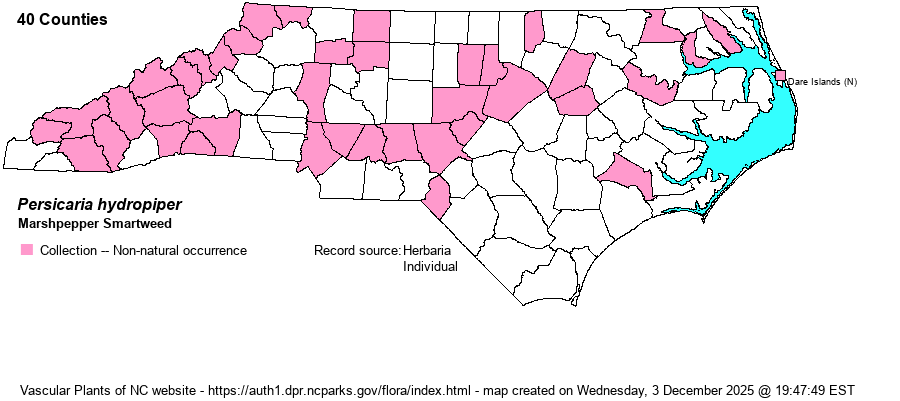| Author | (L.) Spach | |
| Distribution | Mostly in the Mountains, Piedmont, and northern Coastal Plain. Specimens at the SERNEC database were mixed with P. hydropiperoides, and thus the website editors hope that we have teased them apart such that our map is accurate.
Native of Europe; in N.A. throughout the U.S. and southern Canada. | |
| Abundance | Frequent in the Mountains, uncommon in the Piedmont, rare in the Coastal Plain. | |
| Habitat | Usually in disturbed wet places, such as roadside ditches, disturbed marshes, creeksides, pastures, meadows, pig pens, cropfields, moist woods. | |
| Phenology | Flowering and fruiting May-November. | |
| Identification | This species is often confounded with the native P. hydropiperoides, not only because the names are similar, but physically they are similar. In NC, the great majority of P. hydropiperoides individuals have narrower and longer leaves than P. hydropiper, and the flowers are not punctate. It is very similar to P. punctata, but that species has shiny and smooth seeds (vs. dull and minutely roughened in these two species). | |
| Taxonomic Comments | Weakley (2018) gives the author as (L.) Opiz, while FNA gives it as (L.) Spach.
Many species formerly treated in the genus Polygonum have been moved to Persicaria, the smartweeds. These are generally erect and tall plants with terminal and axillary floral spikes; most occur in wetlands. Others remain in Polygonum, the knotweeds, which are generally prostrate to ascending and with inconspicuous axillary flowers. They occur mostly in dry soils and tend to be weedy.
Attention must be paid to the small collars at the junction of the main stem and leaf stems (called ocreae) and whether they possess terminal hairs or bristles. Some keys also refer to the even smaller collars from which flowers emerge (called ocreolae). Another important ID character is the surface of the greenish sepals -- whether smooth or dotted with indentations (punctate). | |
| Other Common Name(s) | | |
| State Rank | SE * | |
| Global Rank | GNR | |
| State Status | | |
| US Status | | |
| USACE-agcp | OBL link |
| USACE-emp | OBL link |

